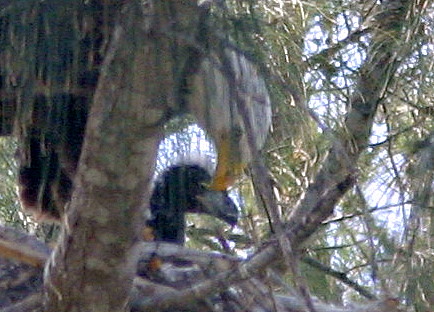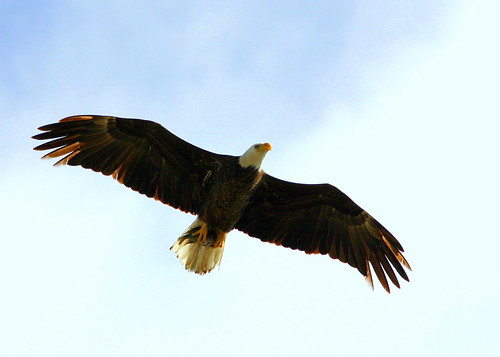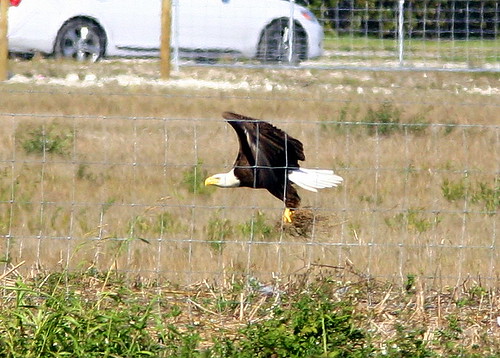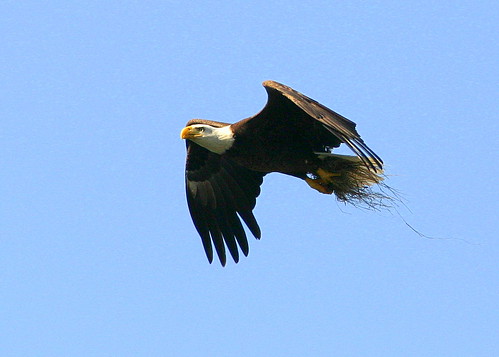Their parents will begin to deprive them of food and entice them to move about and test their wings by flapping in place. They will also lose weight in preparation for free flight. Any undue disturbance may startle an eaglet and cause it to fall to the ground. Because the adults have eight foot wingspans, they cannot fly down among the trees to feed their chick. Even if it survives the fall, the youngster will die of starvation or be eaten by predators. If anyone notes that an eaglet has fallen or is missing from the nest, please immediately notify eagle biologist Brian Mealey of the Institute of Wildlife Sciences at (305) 975-0200. Brian will try to retrieve it.
It follows then, that it is important for all observers to avoid sudden movements and not let children or pets run about in the area in front of the nest. Never walk directly towards the nest, as this can alarm the birds. Of course, do not enter the wooded area. Ideally, all observations should take place from the north side of Pines Boulevard, as viewers will be about 300 feet from the nest, a much more comfortable distance for the eagles. The parents are not likely to abandon the nest once the chicks have hatched, but disturbance could cause changes in their behavior. So far this has not happened. The chicks are being fed and the adults are roosting in nearby trees or even at the edge of the nest at night, despite the presence of so many human visitors.
Both adults rested in the melaleuca snags to the west of the nest. The female is on the upper right. Note her larger size (even accounting for her slightly nearer position) and the thicker base to her beak:
The chicks ate well. One adult (presumably the male) brought in a medium-sized white bird (probably an ibis or Cattle Egret). The other adult proceeded to pluck it at the nest as the chicks looked on. White feathers were flying everywhere.
Periodically, the chicks were fed good-sized portions of the prey bird’s meat:
Sunday, February 22, 2009: The number of visitors remained quite high,and nearly everyone observed traffic regulations. Since viewers congregate near the roadway and some motorists do not even slow down as they pass all the parked cars and people, it is essential that children be kept under control.
There is one disturbing event to report. A photographer with a very large camera, and decked out in camoflauged gear, entered the woods directly in front of the nest (about 150 feet from the nest tree) and presumably approached it. Possibly a “professional,” he is someone who should have known better. Not only was he trespassing, but he was creating a disturbance within 330 feet of the nest, which is forbidden by state and federal guidelines. Lay observers who did not even know about the Bald Eagle protection rules or the American Birding Association’s Code of Birding Ethics
Visitors are asked to park in the grass, several feet away from the pavement of busy Pines Boulevard. The eagles seem to be more tolerant of vehicles than humans, so observers should avoid walking towards the nest. Since the eagles can be disturbed by excessive motion, eagle watchers should observe quietly and not permit children to run about.
The oldest of the two chicks (on the left in the above photo) was hatched on January 17th, making it 34 days old today. Both have grown quickly. Their dark beaks are now almost as large as those of their parents, and their fuzzy white coat of down is being replaced by black feathers. It will be five years before they acquire the yellow beaks and white head and tail feathers of their parents.
Yesterday morning, we watched as one of the parents brought in a medium sized fish. It appeared to be a tilapia. Fish is a staple food for eagles. They pluck them from the surface of suburban lakes, or steal them from the Ospreys. They sometimes catch water birds, such as ducks, egrets and ibises.
After feeding the chicks, the adult cleaned its bill and roosted at the top of a nearby Australian Pine:
The eagle launched from its treetop perch:
It flew to a nearby pasture, where it gathered grasses in its talons, then leapt into the air:
The eagle carried the grass to the nest, where it carefully added it to the lining:
Visit these pages for more information about the Pembroke Pines Bald Eagles:
Watching the Bald Eagle Nest
History of the Pembroke Pines Eagles
Here is a slide show of Ian Eisenberg’s photos of the Pembroke Pines Eagles, including some stunning views of the chicks being fed:





















